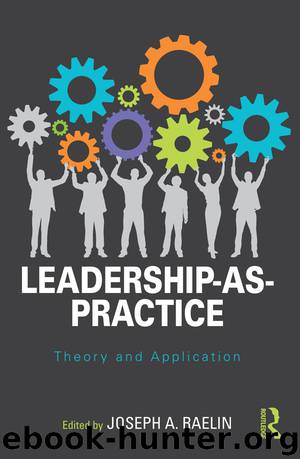Leadership-as-practice by Raelin Joseph A

Author:Raelin, Joseph A.
Language: eng
Format: epub
Publisher: Taylor & Francis (CAM)
Another, similar comment was offered by Brandt (a senior manager):
Being employed in Attractor is not about being good enough theoretically but about daring to let go of perfection and to be present. I practice this in relation to all new employees. I give people a kind of a paradoxical message: You can become much better, but at the same time you are good enough—otherwise you would not be here!
(quoted in Storch & Shotter, 2013)
If, as Barker suggests above, leadership involves a developing, dynamic process of intra-activity, then leadership roles cannot be (and, perhaps, should not be) clearly defined. There are no ideal forms of it. Thus, just as Winnicott (1988) suggested the term “good-enough mothering,” both “to convey an unidealized view of the maternal function,” while still holding in mind the “absolute dependence” of the baby on its environment, while it is “always travelling towards (but never reaching) independence” (p. 90), so we (Storch & Shotter, 2013) suggested the notion of “good-enough leadership” for similar reasons. In other words, we saw a leadership process at work in Attractor that began much as mothering begins, with a sensitivity and a responsiveness to what she senses as our needs (Todes, 2001)—the unsatisfied tensions she can perceive us as feeling in the incipient, that is not-yet-wholly-clear intentions she can see us as trying to execute—as she feeds, comforts, plays, and otherwise actively intra-acts with us.
And what such a mother does for us, in our learning to become an autonomous, self-controlling member of our own society and culture, is not to sit us in a classroom and to embark on teaching us in accord with a pre-planned curriculum, but to circumstance or to occasion (Adato, 1980) situations in which we can, not only satisfy (some) of our incipient intentions, but also learn from her their social value, their meaning. Thus, at this early stage in our development, it is our “tryings” (and “failings”) that are important to her, not our achievements. Storch, in approaching the employees in Attractor in a similar manner (as they themselves described it), seemed to have created a company of consultant-practitioners able to develop (and sustain) their own autonomous ways of working, while at the same time, still displaying and sustaining a certain “house style.” As I see it, Dan is depicted as just such a “good-enough” leader in Carroll’s account (Chapter 5, this volume).
Also, as Simpson (Chapter 8, this volume) illustrates, whereas inter-actions, as we call them, start with independently defined actors, and lead us into investigations of what happens between them, trans-actions—or intra-actions, as I have called them—lead us into conducting our inquiries in a very different fashion, into observing and inter-relating a whole range of detailed activities within the organization in question. As she points out:
If organizational practice is understood as the unceasing flow of actions by means of which work is accomplished, then leadership surely resides in those emergent turning points, or leadership moments, that re-orient the flow of practice towards new, or at least different, directions.
Download
This site does not store any files on its server. We only index and link to content provided by other sites. Please contact the content providers to delete copyright contents if any and email us, we'll remove relevant links or contents immediately.
Hit Refresh by Satya Nadella(8855)
The Compound Effect by Darren Hardy(8513)
Change Your Questions, Change Your Life by Marilee Adams(7377)
Nudge - Improving Decisions about Health, Wealth, and Happiness by Thaler Sunstein(7244)
The Black Swan by Nassim Nicholas Taleb(6770)
Deep Work by Cal Newport(6563)
Daring Greatly by Brene Brown(6227)
Rich Dad Poor Dad by Robert T. Kiyosaki(6179)
Principles: Life and Work by Ray Dalio(5961)
Man-made Catastrophes and Risk Information Concealment by Dmitry Chernov & Didier Sornette(5650)
Playing to Win_ How Strategy Really Works by A.G. Lafley & Roger L. Martin(5506)
Digital Minimalism by Cal Newport;(5391)
Big Magic: Creative Living Beyond Fear by Elizabeth Gilbert(5353)
The Myth of the Strong Leader by Archie Brown(5239)
The Slight Edge by Jeff Olson(5200)
Discipline Equals Freedom by Jocko Willink(5157)
The Motivation Myth by Jeff Haden(5004)
Stone's Rules by Roger Stone(4859)
The Laws of Human Nature by Robert Greene(4774)
